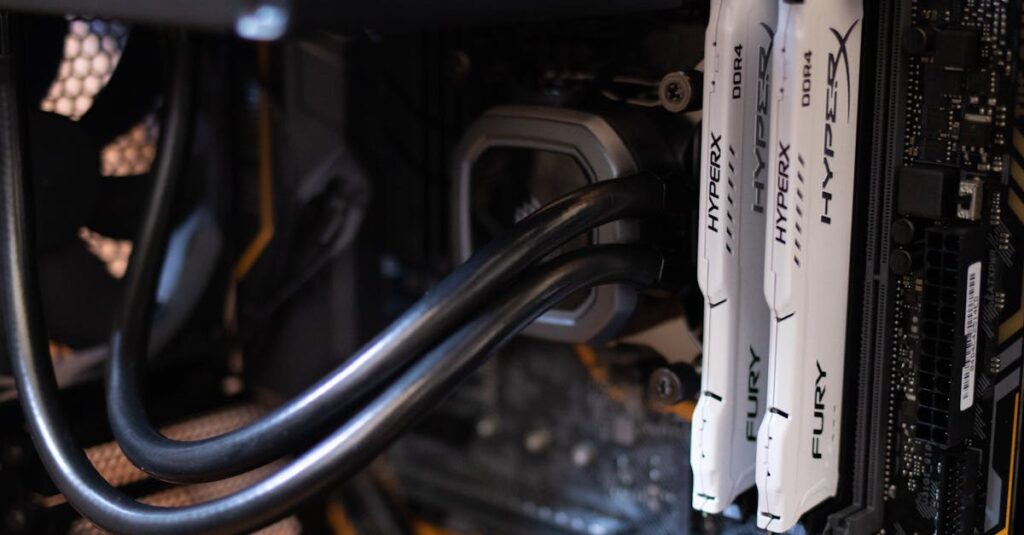In the fast-paced world of technology, blade servers are the sleek, efficient superheroes of data centers. They pack a punch by maximizing space while delivering top-notch performance. Imagine a room full of servers, but instead of a chaotic tangle of wires and boxes, you’ve got a well-organized lineup of slim, powerful blades ready to tackle any task.
Table of Contents
ToggleOverview of Blade Server Configurations
Blade server configurations consist of multiple components working together efficiently. These configurations feature a blade chassis that houses several blade servers, optimizing space and resource utilization in data centers. Performance varies based on server specifications, including processors, memory, and storage options.
Management capabilities are essential in these configurations. Organizations utilize centralized management tools for monitoring and controlling multiple blade servers simultaneously. This approach simplifies administration and enhances the overall efficiency of IT operations.
Scalability presents another key aspect of blade server configurations. Companies can easily add or remove blade servers as their needs change without significant disruptions. This flexibility supports varying workloads, enabling organizations to adjust quickly to demand fluctuations.
Power and cooling considerations are crucial in any configuration. Blade servers often incorporate advanced technologies that reduce energy consumption and improve thermal management. Effective cooling solutions help maintain optimal operating conditions, prolonging hardware lifespan.
Security measures play an integral role as well. Configurations typically include features like secure access protocols and virtualization. These enhancements protect sensitive data and ensure compliance with industry standards.
Ultimately, blade server configurations provide a high-density computing solution tailored to modern data center requirements. The combination of performance, efficiency, and adaptability makes them a preferred choice for many enterprises.
Benefits of Blade Server Configurations
Blade server configurations provide numerous advantages, making them a compelling choice for data centers. Their design features contribute significantly to operational effectiveness.
Space Efficiency
Blade servers utilize a compact form factor. This compactness enables the integration of multiple servers in a single chassis, maximizing floor space. Data centers with limited real estate benefit from this efficient setup. By reducing the necessary physical footprint, organizations can allocate more room for additional equipment or other operations. Their organized structure minimizes cable clutter, simplifying maintenance and reducing potential downtimes. An organized arrangement ensures that cooling systems operate more effectively since airflow remains unobstructed.
Energy Efficiency
Blade servers deliver significant energy savings compared to traditional setups. These servers often share resources like power supplies and cooling systems, which streamlines energy consumption. Advanced energy-efficient technologies in blade servers reduce overall power usage significantly. Centralized management tools help monitor energy usage, allowing IT teams to make informed decisions to enhance efficiency. Organizations benefit from lower electricity costs, promoting a sustainable operational model. Furthermore, the improved thermal management capabilities of blade servers minimize heat output, contributing to an overall reduction in cooling requirements.
Types of Blade Server Configurations
Blade server configurations come in various types, each designed to meet specific organizational demands. Understanding these types provides insight into optimizing data center operations.
Vertical Blade Servers
Vertical blade servers feature an upright design, allowing efficient use of space. These units occupy less horizontal footprint, making them suitable for dense environments. They often offer high scalability, facilitating easy addition of new servers to the existing setup. Performance-oriented tasks benefit significantly from their architecture, which supports powerful processors and memory integration. Many organizations prefer vertical blade servers due to their streamlined airflow management, promoting better cooling and energy efficiency. Overall, this configuration proves effective for businesses seeking to maximize server density while minimizing infrastructure costs.
Horizontal Blade Servers
Horizontal blade servers present a flat design, providing a wide layout that accommodates numerous units side by side. These servers excel in scenarios requiring extensive processing power and high availability. Their layout simplifies maintenance and access, allowing easy replacement or upgrades without disrupting other components. Featuring robust resource sharing capabilities, horizontal blade servers reduce infrastructure overhead by consolidating power and cooling systems. Organizations aiming for flexibility often choose this format due to its adaptability in shifting workloads. Enhanced thermal management increases operational efficiency, making horizontal blade servers an appealing option for versatile data center needs.
Key Components in Blade Server Configurations
Blade server configurations consist of several key components that work in harmony to optimize data center performance.
Blade Chassis
A blade chassis serves as the central housing unit for multiple blade servers. This structure maximizes space efficiency by allowing several servers to fit into one compact frame. Advanced design features support better airflow and cooling, which are crucial for maintaining optimal operating temperatures. Moreover, power distribution units within the chassis provide resources to individual blades, simplifying energy management. Integrated management interfaces also enhance monitoring capabilities, enabling IT personnel to oversee performance metrics effectively.
Blade Server Modules
Blade server modules represent the individual servers mounted within the chassis. Each module typically houses processors, memory, and storage resources, tailored to specific workloads. Different modules allow for customization based on operational requirements, ensuring optimal performance for applications. These server modules support high-density configurations, which lead to increased computational power while saving physical space. Resource sharing among the blade servers further enhances efficiency, reducing the overall infrastructure footprint in data centers.
Considerations for Choosing Blade Server Configurations
Selecting the right blade server configuration requires careful evaluation of several factors. Organizations must prioritize performance needs, as specifications influence processing power and efficiency. Scalability is essential; the configuration should allow for seamless expansion as workloads grow.
Energy efficiency plays a significant role in long-term operational costs. Choosing configurations that utilize advanced power management technologies can lead to substantial savings. Space utilization also deserves attention; a compact design maximizes available real estate in data centers.
Cooling solutions affect the sustainability of blade servers. Effective thermal management prevents overheating and prolongs hardware lifespan, making it a crucial consideration. Organizations must also evaluate management tools that provide centralized oversight, improving monitoring and operational efficiency.
Security factors cannot be overlooked. Blade servers require configurations that support secure access and data protection protocols. Compatibility with existing infrastructure is vital, ensuring seamless integration and minimizing disruptions. Vendor support also matters; reliable service can facilitate maintenance and troubleshooting.
Lastly, budget constraints influence configuration choices. Cost-effectiveness must be assessed alongside features and performance capabilities, ensuring that organizations receive the best value for their investments. Making informed decisions on these considerations leads to optimal blade server configurations that meet both immediate and future demands in data center environments.
Conclusion
Blade server configurations stand out as a superior choice for modern data centers. Their compact design not only maximizes space but also enhances performance and energy efficiency. With options like vertical and horizontal setups, organizations can tailor their configurations to meet specific workload demands.
Centralized management tools simplify operations while ensuring optimal resource utilization. As businesses grow and evolve, the scalability of blade servers becomes a crucial asset. By prioritizing key considerations such as cooling solutions and security measures, organizations can effectively leverage blade server technology to achieve sustainable and efficient IT operations. Investing in the right blade server configuration can lead to significant long-term benefits for any enterprise.





